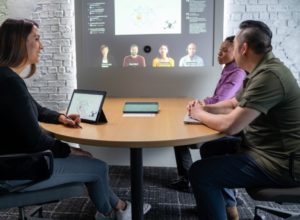


How Microsoft approaches hybrid work: A new guide to help our customers
Today, Satya shared Microsoft’s broad approach as we transition to hybrid work, and we’ve taken that approach as we talk with our customers in the field.
View live transcripts in Microsoft Teams meetings, track Excel changes, and increase hybrid work security—here’s what’s new to Microsoft 365
As our customers around the world look for new ways to empower people for hybrid work, we’re committed to offering them experiences that enable everyone to connect and collaborate from home, at the office, and everywhere in between.
How Microsoft Teams is powering hybrid work and the frontline in manufacturing
We have learned over the past year that no business is impervious to everything. We also learned—or were reminded—how critical manufacturing ecosystems are to our daily lives. From essential commodities like toilet paper to life-saving personal protective equipment and ventilators, manufacturers really stepped up during the pandemic.
Hybrid work is here. Are you ready?
At Microsoft, we believe that hybrid work is the future. Moving forward, every organization will need a new operating model for hybrid work—one that doesn’t rely on old norms, like the 8-hour, 9-to-5 workday.
Flexible work is here to stay: Microsoft 365 solutions for the hybrid work world
For some people, 2020 felt like the year work and learning moved home. For others, work continued to happen on-site—with the added challenges of staying safe on the job and learning new ways to connect to remote colleagues. But the reality is: 2020 is the year work and learning moved to the cloud.
Microsoft Viva: Empowering every employee for the new digital age
Even before COVID-19 turned our lives upside down, a new generation of digital tools was opening up new possibilities for the future of work.
New people-centered experiences in Microsoft 365, the world’s productivity cloud
Today at Microsoft Build 2019, we announced the latest innovations in Microsoft 365. We first launched Microsoft 365 almost two years ago by bringing together Office 365, Windows 10, and Enterprise Mobility + Security into a single solution.
MyAnalytics, the fitness tracker for work, is now more broadly available
MyAnalytics—the fitness tracker for work—will be available to everyone using Office 365 and Microsoft 365 Enterprise and Business suites that include Exchange Online. Previously, MyAnalytics was only available with an Enterprise E5 plan or as an add-on to E1 and E3 plans.
Introducing Workplace Analytics solutions and MyAnalytics nudges
Collaboration habits can make or break teamwork. When people run efficient meetings, create time for focused work, and respect work/life boundaries their teams thrive. Putting these habits in place is difficult and takes the support of the entire team. Data can create a common language to help members build consensus on important teamwork norms.
